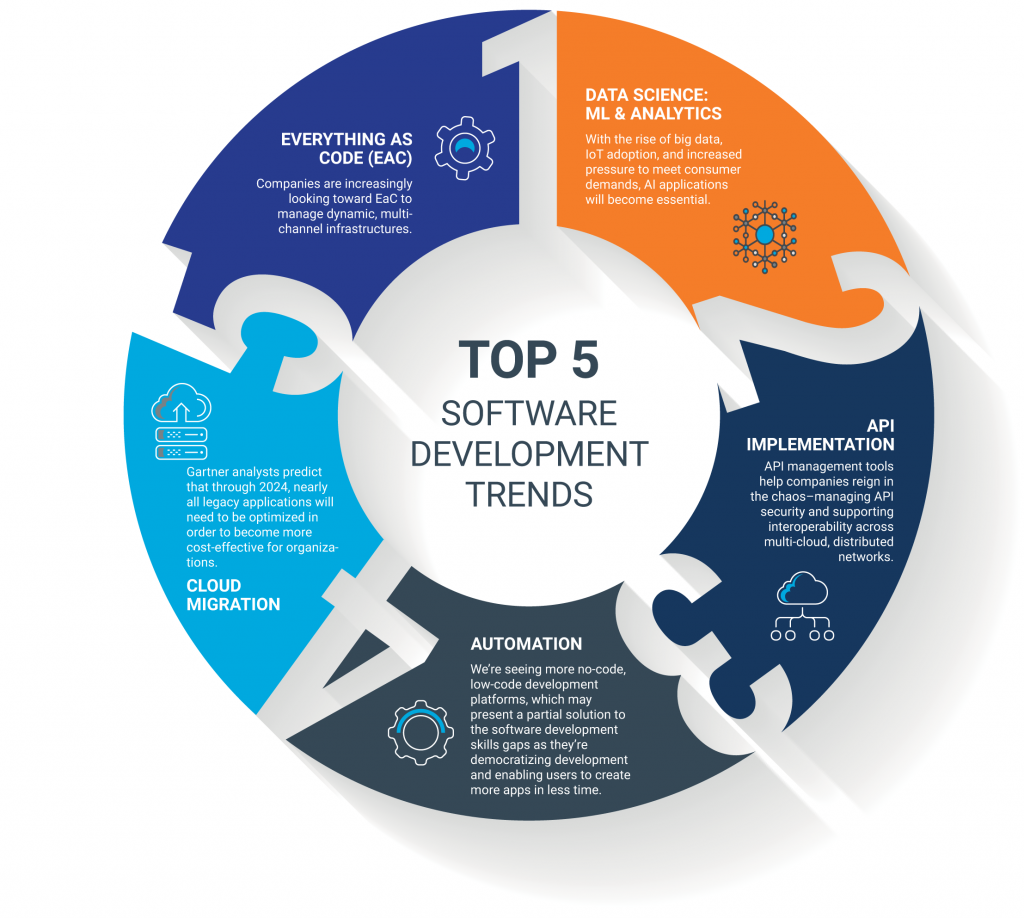
Current State of Software Development
Customer experience is now the most critical element of any business’ strategy across all industries, whether we’re talking about mom-and-pop shops, global enterprises, or highly-regulated markets like healthcare or financial services.
From analytics and AI to a wide range of cloud-based solutions, delivering the kinds of experiences customers not only crave but expect means investing in the right technology. In fact, IDC predicts that by 2022, digital products, services, and operations will account for around 80% of revenue growth across all industries.
In the first installment in this series, we’ll take a look at where the software development landscape is right now. We’ll examine trends, challenges, and where we’re headed beyond 2020.
Industry Overview: Current Software Development Trends
Before we really dig in, it’s important to note the main driver behind the latest software development trends is the push toward customer-centricity. Ultimately, the goal is to provide customers with “seamless,” “relevant,” “omnichannel” experiences, while everything else focuses on helping developers deliver those solutions faster and cheaper–without compromising on quality.
That said, here’s a look at the key factors shaping the current software development landscape and what’s driving these major shifts.
- Cloud-Native Apps. Cloud-computing has become standard for enterprise applications. Over the past few years, we’ve seen companies move their core business functions to the cloud. This step allows them to capture and sync data across multiple applications and thus enables them to learn more about their customers and their habits, as well as creates the opportunity for users to access applications from anywhere. Now that remote work is the norm, cloud-based apps are considered essential for workers clocking in from home.
- Big Data & Analytics. Brands are increasingly looking toward solutions that help them capture and analyze data to make apps more “sticky” among their target audience. As such, there’s a rising demand for data management solutions that are affordable and provide self-serve access to critical insights, as well as solutions that help organizations manage massive, distributed datasets and the architecture to support them.
- Intelligent Applications. Apps with artificial intelligence (AI) and machine learning (ML) capabilities are becoming both more accessible and essential. Organizations are increasingly looking toward solutions that can be used to help them automate tasks, offer personalized experiences, and provide predictive and prescriptive services.
- Multi-Sensory, Multi-Channel Experiences. These days, nailing the cross-channel experience isn’t enough. Customers want innovative, multi-sensory experiences that bring something new to the table. Increasingly, we’re seeing retailers, sales reps, educators, and more incorporate technologies like AR, VR, and mixed reality into their existing engagement strategy, bringing more value to the virtual experience.
According to Salesforce’s latest State of the Connected Consumer report, 75% of customers expect companies to use new technologies to deliver better experiences.
The report noted that the “pressure is on” for brands to innovate faster and embrace emerging technologies like AI and IoT that can help them understand their audience and deliver the messaging and solutions that best align with consumer needs, preferences, and expectations.
- Privacy & Security. According to a report by Cybersecurity Ventures, damage caused by cybercriminals will cost a collective $6 trillion by 2021, a figure greater than the damage caused by global natural disasters each year. As companies continue to embrace cloud-based solutions and IoT applications, they’re looking toward software solutions to keep sprawling systems secure and in compliance with consumer privacy regulations like CCPA and GDPR.
Top Programming Languages & Technologies
According to the Tiobe Index, Java, Python, C/C++/C#, and even PHP are the most in-demand programming languages as of October 2020.
Another recent report from Stack Overflow found that Python is the most in-demand language, followed by JavaScript, Go, TypeScript, and Kotlin.
While Python has been around for awhile, its recent rise can be attributed to its role in data science, machine learning, AI, and developing IoT apps. C/C++ are used to develop web and desktop apps, Go is best-suited for distributed, networked services, cloud-native development, and microservices projects, and TypeScript is becoming essential for helping developers maintain code quality as projects become larger and more complex.
Additionally, modern development teams are building out tech stacks that support project management, collaboration, containerization, data science, and more.
The same Stack Overflow report shares that React and Vue are the most loved frameworks among developers, while jQuery and Drupal are the most dreaded. MongoDB is the most-wanted database tool, while Linux, Docker, and Kubernetes are the most loved platforms. The report also found that many developers said they wanted to start using Docker and AWS in the near future.
Code Sans’ 2020 State of Software Development found that while 60% of teams communicate project deadlines via in-person meetings, 46% use task/issue-tracking tools to keep track of key milestones.
Ultimately, 2020’s “top tools of the trade” reflect the trends that currently define the space: cloud-based apps, AI, ML, big data, analytics, and the IoT.
Top 5 Software Development Trends for 2021
The biggest software development trends on the horizon appear to focus on tackling the challenges development teams and enterprise users face today–whether that’s making analytics more accessible to the business user, enabling development teams to deploy solutions faster, or helping organizations control and manage increasingly complex digital ecosystems.
Here’s a look at five software development trends we anticipate will be big in 2021 and beyond.
- Data Science: ML & Analytics. Sure, AI is already widely used in all industries. However, with the rise of big data, IoT adoption, and increased pressure to meet consumer demands, sophisticated AI applications will become essential for doing business.Organizations are looking for applications that help them interpret and manage growing data sets to gain a 360-degree view of the customer, get the most value from their IoT investments, as well as predict and respond to changes in the market.
- API Implementation. With more businesses continuing to develop distributed application ecosystems, API management tools represent a growing share of the software development marketplace. What’s driving this demand is the fact that API ecosystems are getting more diverse and complex.For example, a company might use several SaaS apps–think CRMs, inventory management tools, marketing automation apps, etc., all hosted on separate public cloud platforms that the end user has no direct control over. That same company might also have a few custom builds in that tech stack, hosted by a private cloud provider.Additionally, the IoT continues to grow, which means more organizations are using non-standard APIs connected to a range of sensors, equipment, and devices. API management tools help companies reign in the chaos–managing API security and supporting interoperability across multi-cloud, distributed networks.
- Automation. As an “emerging software industry trend,” there’s certainly some overlap between automation and AI/ML/big data. However, here, we’re looking at automation from the developer side, rather than the end-consumer perspective. In order to keep pace with client demand, developers and ops teams are increasingly looking toward automation to bring software to market faster.More and more, we’re seeing automated quality assurance and security testing, as well as robotic process automation (RPA) to take on repetitive tasks at speed and scale, allowing development teams to become more productive and focus their efforts on coding.Additionally, we’re seeing more no-code, low-code development platforms, which may present a partial solution to the growing software development skills gaps as they’re democratizing development and enabling users to create more apps in less time.According to a recent report, the low-code development market is projected to hit $83.5B by 2028. Researchers cited rising demand for business digitization, stringent regulatory requirements, and less dependency on traditional IT departments (and infrastructure) as the main factors driving growth in this space.
- Cloud Migration. Cloud migrations will continue to grow through 2021 and beyond. While cloud adoption has been steadily rising over the past decade, customers are increasingly moving on-premises computing environments to the cloud post-COVID to support remote work, offer flexible access to business data and essential applications, as well as optimize costs.In a recent report from Gartner, analysts predict that through 2024, nearly all legacy applications that have been migrated to public clouds will need to be optimized in order to become more cost-effective for organizations. As such, we’re likely to see the market for third-party cost-optimization tools to expand in the near-term, further increasing adoption to become more cost-effective.
- Everything as code (EaC). Companies are increasingly looking toward EaC to manage dynamic, multi-channel infrastructures. EaC allows teams to write infrastructures as code, building programmatic workflows that replace repetitive, manual DevOps tasks that enable organizations to manage infrastructure with the same processes used to build software.
Final Thoughts
We’re already at a point where businesses live and die by their ability to leverage the latest technology to enhance the customer experience, understand the market, and serve up innovative solutions.
Whether companies consider themselves “tech-driven” or not, we now live in a world where software development is central to any business’ strategy, and as such, organizations can’t afford to treat their technology strategy and business strategy as separate entities.
[adinserter name=”Software-Development-Closing”]
[adinserter name=”Software-Development-eBook-Offer”]
Recent blog posts

Stay in Touch
Keep your competitive edge – subscribe to our newsletter for updates on emerging software engineering, data and AI, and cloud technology trends.




